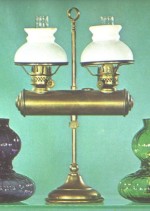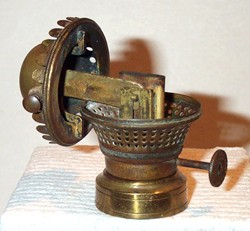Charles F. Spencer was a prolific inventor whose contributions spanned at least three decades during the mid- to late-1800's. It would appear that around every corner, Spencer saw a better way; his mind must have been stuck in overdrive. The beauty of Spencer's innovations was not in their sheer numbers, but rather in their diversity. While his lighting inventions and possible association with another Rochester entrepreneur, Henry E. Shaffer, originally piqued my interest, I became more intrigued with Spencer as I uncovered a legacy of unrelated innovations and improvements to everyday items; items that were used essentially from the cradle to the grave. In addition to his lighting patents, the first patent I discovered was for a child's see-saw that he patented on May 5, 1891. Later, I located two patents for burial coffins issued to Spencer in April and September, 1877. Other patents soon surfaced and the story unfolded.
In the 1880 census, Charles' occupation is listed as "inventor." Again, no children are listed and he and Esther were then in their early forties. Esther's entry lists her occupation as "keeping house," so it is assumed that she was not a working woman at that time. In the 1910 U.S. Census entry for Esther, there is the numeral "1" in the column headed Number of Children Born, and a zero in the column headed Number of Children Living. This confirms that the Spencers did try to start a family and suffered a tragic loss. It is not known when the child was born or died. Esther R. Spencer entered into rest on May 2, 1917 at the age of 81.
Esther's father, Richard Gorsline, entered the patent arena in 1868 when he patented an improvement in lamp burners on July 28th of that year. His invention, patent number 80,281, was a wire-framed, glass-bottomed burner plate designed to improve light output otherwise obstructed by conventional burner construction. On June 1, 1886, Esther R. Spencer was granted patent number 342,940 for lacing bearings. These were essentially eyelets for corset laces. She assigned three-fourths of this patent to Joseph C. Wilson and Hobart F. Atkinson. On the same day, Wilson was granted a similar patent, number 343,146. Wilson assigned one-half to Esther and Atkinson. Esther obtained a second patent on May 31, 1887 for a similar improvement, this patent being assigned to The Self-Adjusting Corset Company of Rochester. An advertisement in the 1888 Rochester directory for The Self-Adjusting Corset Company notes that they are the "Sole owners and manufacturers of the Wilson patent." I assume this is for the Wilson patent previously noted. It also advertises "W.S.A. Corsets." Could this stand for Wilson, Spencer and Atkinson? Perhaps Esther was dabbling in a business venture. The evidence suggests it. There is no evidence that Charles was involved in the patent rights to any of his family member's patents, but it would not surprise me if he was.
In his 1972 article, "Flour City's Jars," William Putzier concluded that the 1872 fruit can patent was from the "Rochester" Spencer. I have a strong suspicion that it was not, although the evidence is inconclusive. There was a Charles F. Spencer living in Cleveland during that time, but he had been there most of his life. He appears in the Cleveland City directories for many years prior to, and well past the time period when the "Rochester" Spencer is absent from the Rochester directories, and indeed long after our Spencer had passed on. In 1872, "Cleveland" worked as a cashier at Smith & Curtiss, 125 Superior. Smith & Curtiss was a wholesale tea, coffee and spice business. Spencer remained with the firm through the 1870's. "Cleveland's" design could have arisen from his work environment and this can could have easily been invented for any of the sundries carried by the store. In the patent document, Spencer mentions fruit, oysters and paint as possible applications. Was our Spencer in Cleveland at the same time? We may never know, but he certainly doesn't appear to have been in Rochester. There are a number of unanswered questions regarding Spencer in the early 1870's. As noted above, there is no entry for either of them in the 1870 census. It is also around this time that he is conspicuously absent from the directory listings: from 1871 through 1876. This could merely mean that he relocated outside the Rochester city limits. Additionally, if you look at his patent history, and dismiss the patents attributed to the Cleveland Spencer, there is no known activity between February, 1870 and December, 1875. Even if he and Esther had moved, what would explain the lull in his creative capacity? The patents from the Cleveland Spencer complete the void in the patent listing. It certainly makes you wonder what was going on during that period of time and where exactly he and Esther were. To add even more mystery, at the end of Esther's obituary it reads, "Cleveland and Los Angeles papers, please copy." But why?
C.F. Spencer obtained sixteen lighting-related patents over his lifetime. Two of his early lighting patents, numbers 63,321 and 66,902, both issued in 1867, were for improvements in dead-flame lanterns. Both patents were assigned to himself and Charles W. Barker. Barker appears to only be listed in the 1868 Rochester City Directory. There were a number of lantern makers from the Rochester area. Further research in this area might uncover which firm, if any, incorporated Spencer's innovations into their products, but the likely suspect is Kelly & Company (which would become The Kelly Lamp Works), manufacturers of lanterns and locomotive head lamps. Spencer's last lighting patent for a hanging lamp, number 236,792 from January 1881, was assigned to Adam Zimmer. Many of Spencer's lighting patents are covered in the text that follows. Follow this link to view a chronological listing of Spencer's patents. In addition to the items previously mentioned, the following are excerpts from the Union and Advertiser from 1858 through 18854 which further show the breadth of Spencer's innovative mind:
An article in the Union and Advertiser dated April 21, 1864, entitled "Another Rochester Invention - Spencer's Patent Burner" reads: "In the use of petroleum and kerosene lamps everybody knows the inconvenience of removing and replacing chimneys for the purpose of filling, trimming, and lighting lamps. It is in this process that many chimneys are broken, and there is at the best a considerable loss of time. A number of inventions have been brought out to obviate this difficulty, but all are liable to objections except the last one by Mr. Spencer." Spencer apparently lost no time in successfully pitching his invention to a manufacturer. "One of the largest manufacturing concerns in the east, with headquarters in New York, at once engaged to manufacture these burners, on a tariff, and has made arrangements to produce three hundred thousand dozen a year (author's note: that's over three and a half million burners!). It will be offered to the trade in about four weeks, and there is no doubt but it will be the first and only burner sought for in less than sixty days after its introduction." The article further noted that "W.S. Thompson, at 51 State street, who has been so largely engaged
On September 28, 1864, a follow-up article in the Union and Advertiser entitled "Spencer's New Burner" reads: "It was announced some time since that our townsman, C.F. Spencer, had invented and patented a burner for kerosene lamps which was to displace all others. Since that time arrangements have been in progress for the manufacture of these burners on a large scale and are now complete." The article goes on to say, "The invention is very simple but effectual for the purpose sought. The chimney of the lamp is not removed when it is to be lighted or trimmed. It turns over at will [see patent drawing above], and when in its place is immovable, and all this without springs, catches or screws... Large quantities of these new burners have been made and will be at once introduced to the trade all over the country," and Spencer's invention is "...applied to No. 2 burners as well as those of smaller size, and this is not the case with other turn overs." Finally, "It has been discovered that this burner improves the light - as it causes more perfect combustion, though we believe this was not thought of by the inventor, but is now readily accounted for on well known principles."7 Having read these two articles, one might believe that obtaining a specimen of the Spencer burner for research would be a simple task. This is not the case. A production model of this burner remains highly elusive. I have contacted more than two dozen advanced lighting collectors with no success. Few are familiar with the burner patent, and no one has an example of this burner in their collection, or is aware of the existence of one. Additionally, despite more limited attempts to locate it, the 1863 burner patent model has not been located. It is my hope that it is "alive and well" in someone's collection and will some day be available for examination and to obtain detailed images of same. Unless the 1864 newspaper articles were all "promotional media hype," or that something went terribly wrong with the order or shipment, I remain confident that one will turn up. Until then, the search continues.
Spencer assigned this patent to Henry E. Shaffer. The 1880 patent date is that of Robert Cartwright, an engineer, also from Rochester. This patent, number 227,731, is generally for the mechanism that allows the lamp to be articulated for use as a wall-hanging lamp. The patent drawing is otherwise nearly identical to the drawing in Spencer's patent application. Cartwright assigned his patent to The Rochester Adjustable Lamp Company. At this time, little is known about this company. In the 1880 Rochester City Directory, Henry E. Shaffer is noted as the treasurer of The Rochester Adjustable Lamp Company at 25 Elwood Block. In the 1881 directory, there is the same listing, but the address is listed as 57 Arcade. It is interesting to note that Henry E. Shaffer is listed as a witness to Cartwright's patent. As you read further, you will discover that Spencer assigned other patents to Henry E. Shaffer. This advertisement for The Rochester Adjustable Lamp Company appears in the 1880 Rochester City Directory.
The lamp depicted is more consistent with the stem mechanism patented by Spencer on October 21, 1879, as is the L-shaped hook included to hang the lamp. This October 21st patent by Spencer, number 220,884, was assigned to Henry Shaffer. Spencer assigned patent number 223,254 issued on January 1, 1880 to Shaffer as well. Two other Rochester inventors, Henry H. Barnard and George V. Hanna obtained a patent for an improvement to an adjustable bracket lamp which they assigned to Shaffer. Barnard and Hanna were business partners in the firm of Barnard & Hanna. They are listed in the business section of the 1880 directory under the heading of "Machinists." In their patent letters, they reference Spencer's lamp when talking about the fount, "...is cylindrical and of a considerable length, and of the same shape as in what is known as the 'Spencer lamp.'" Barnard & Hanna's patent issued on October 21, 1879 (the same day as Spencer's patent) was assigned patent number 220,788. Thus, there is good reason to say that Henry E. Shaffer was actively involved in The Rochester Adjustable Lamp Company, more than just its treasurer, and quite possibly the "brains" behind the whole operation.
One version is a table or stand lamp, shown at right, which is consistent with Spencer's patent number 171,537 granted on December 28, 1875. It is interesting to note that in the pamphlet, and on several examples of the lamp that I have inspected, the patent date is listed as December 21, 1875: I am not aware of an actual patent granted to Spencer on the December 21st date, although it was a Tuesday and other patents were issued on that day. The application for patent number 171,537 was filed on December 21st, so it is assumed that this is the source of that particular date, not the actual date the patent was issued.
The other three lamps depicted in The Manhattan Brass catalog are ceiling and wall mounted versions of the above lamp. These are clearly variations of patent number 179,620 issued on July 4, 1876. These lamps are height-adjustable on a rod which is either attached to the wall or ceiling. While most versions of the lamp were designed for use with seven-inch diameter shades, one larger ceiling version was sold with an adjustable shade holder which would accommodate a ten or twelve inch shade. "This lamp is suitable for Billiard Tables, Parlors, Stores, Store Windows, &c."9
The Spencer wall-mounted lamp patented on April 1, 1879 appeared later that year in the 1879 Rochester City Directory (p. 537) in an advertisement for Jones & Sugru's of No. 43 State Street, Rochester. The partnership of Jones & Sugru dates back at least a decade and they were always associated with Singer sewing machines, as agents, and purveyors of related sundries and sewing notions. The lamp was marketed as The Student Portable Bracket Lamp. It is assumed that these lamps were actually manufactured by them as the patent, number 213,951, was assigned by Spencer to Harry C. Jones and Edward J. Sugru. The design of the lamp was relatively simple and could have easily been assembled by local craftsmen as it basically consisted of brass parts, soldered together, then plated.
Jones and Sugru ran the same advertisement in the 1880 Rochester Directory, but the reference to Spencer, "PATENTED BY CHA'S. F. SPENCER," had been removed. The following year the company is listed as H.C. Jones, successor to Jones & Sugru; no mention of the lamp. By this time E. Jay Sugru had moved on to The Singer Manufacturing Company as their agent. It is not known if this marked the end of production of The Student Portable Bracket Lamp. If so, it was possibly only produced for two years and is likely a scarce find today.
Charles F. Spencer died of paralysis10 on April 27, 1893 at his home, No. 29 West Avenue, Rochester, New York.11 He was buried April 29th in the southeast corner of Lot 7 in Section M of the Mount Hope Cemetery. He was only fifty-nine years of age. Imagine what he might have accomplished had he lived another twenty years and remained an active innovator! Oddly, all that appears in the local newspapers regarding his death is a terse, two-line obituary notice. His final resting place is unmarked. One would think that someone of his apparent stature in the community would have received a more substantial farewell. Sadly, it appears that by 1893, Charles F. Spencer had faded into relative obscurity, not having near the notoriety that he enjoyed during his earlier years.
To view any of the above patents, enter the number in the box below and select Query USPTO Database. This will take you to the specific patent images on the U.S. Patent & Trademark Office Database. Learn more about the USPTO here.
There were a number of night lamps made in the manner or style of Spencer's Double Student Lamp and one similar to the Student Portable Bracket Lamp. Many of these lamps favor the style of W.O. Lincoln's lamp that was manufactured by The Bridgeport Brass Company. In fact, many of these small lamps bear the patent date of October 28, 1879. The lamp on the left mirrors the style of the Spencer lamp, but bears the Lincoln patent date. Other examples are not marked or dated in any manner. It should be noted that these types of lamps were being reproduced as recently as the 1960's and probably later.12 There seems to be little consensus regarding the authenticity of many of these lamps. The only thing that I can say with some certainty is that most Charles F. Spencer's lamps bear patent dates and many include some form of his name. If these lamps were manufactured during the period, and could be attributed to Spencer, I am certain they would be similarly marked. Update, January 6, 2007: I think I may have solved the mystery of the Rochester-Cleveland connection! This was due in part to the recent release of Google's Patent Search which brought to light an additional eleven patents by C.F. Spencer (four of them for lighting) and two more by his father, Apollos. Apollos' final patent was obtained while in Cleveland in 1873. It also helped fill in the absence of patent activity of Charles during the suspect period. A cursory Internet search of the Cleveland burial records showed that Apollos died on June 6, 1874 and is buried in a Cleveland-area cemetery. With this information in hand, I believe that I can document that Charles was in the Cleveland area during the time he was absent from Rochester, and returned to Rochester after his father's death in Ohio. At such time as this can be confirmed, I will formally amend the article to reflect these facts. Update, April 8, 2007:
The burner conforms substantially to the patent drawings and description therein. This particular burner takes a 1-5/8 inch lip chimney and fits a number one collar. The thumb wheel is marked: CF SPENCER PATENT MAR. 24, 1863. I am still puzzled as to why more examples of this burner have not been reported. Perhaps they were produced in more limited quantities than stated in the newspaper articles; perhaps they were not durable or convenient in actual use. Here's another view of the burner in the closed position. At such time as I update the article, I will add additional images. End Notes
References
| |||||||||||||||||||||||||||||||||||||||||||||||||||||||||||||||||||||||||||||||||||||||||||||||||||||||||||||||||||||||||||||||||||||||||||||||||||||||||||
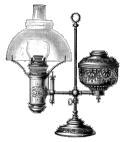
| Reference Desk | Lamp Information | Other Resources | On-Line Shopping |

Purveyors of Antique Lighting and Accessories
435 Main Street
 Hurleyville, New York 12747
Hurleyville, New York 12747
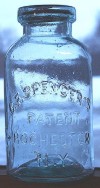 C.F. Spencer's
C.F. Spencer'sPat. no. 37,647 February 10, 1863 Photo: G. Spurgeon --------------------- Enlarge image [+] |
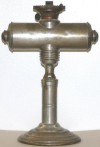 Charles F. Spencer's
Charles F. Spencer'sPat. no. 218,406 August 12, 1879 marked on fount --------------------- Enlarge image [+] |
 Chas. F. Spencer's
Chas. F. Spencer'sPat. no. 207,314 August 20, 1878 marked on top of base --------------------- Enlarge image [+] |
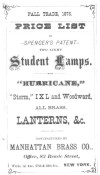 Manhattan Brass
Manhattan BrassFall Trade, 1876 Price List --------------------- Enlarge image [+] |
it's about more than just lamps...

Charles F. Spencer, Inventor
^ Top of Page
Privacy Policy | Terms and Conditions of Use | Announcements
Copyright © 2001-2011 ~ Daniel Edminster | The Lampworks ~ All Rights Reserved
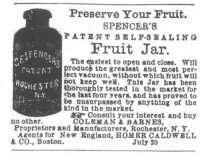
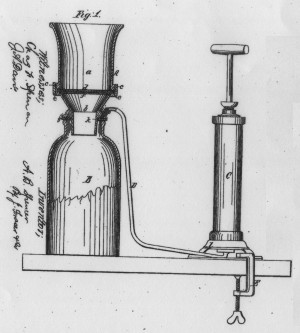
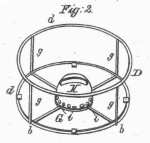
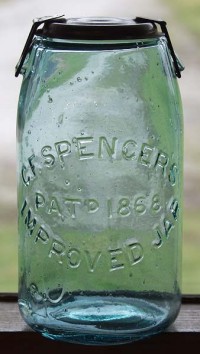
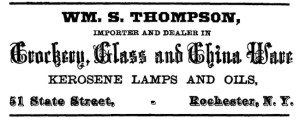
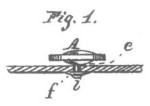


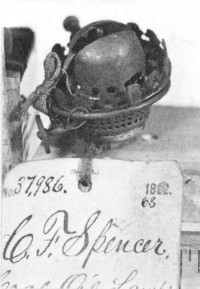
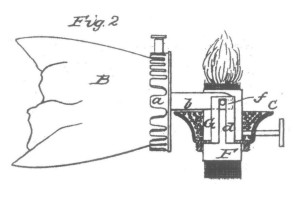
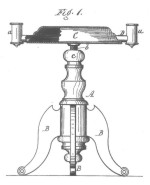
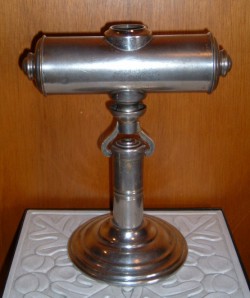

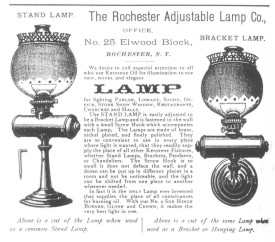
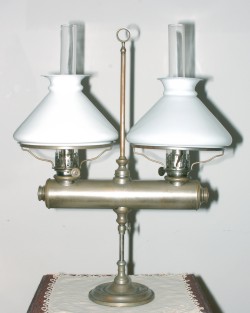


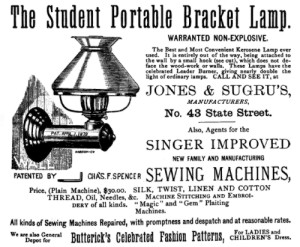
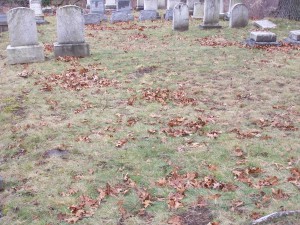
 Search the Patents of Charles F. Spencer
Search the Patents of Charles F. Spencer